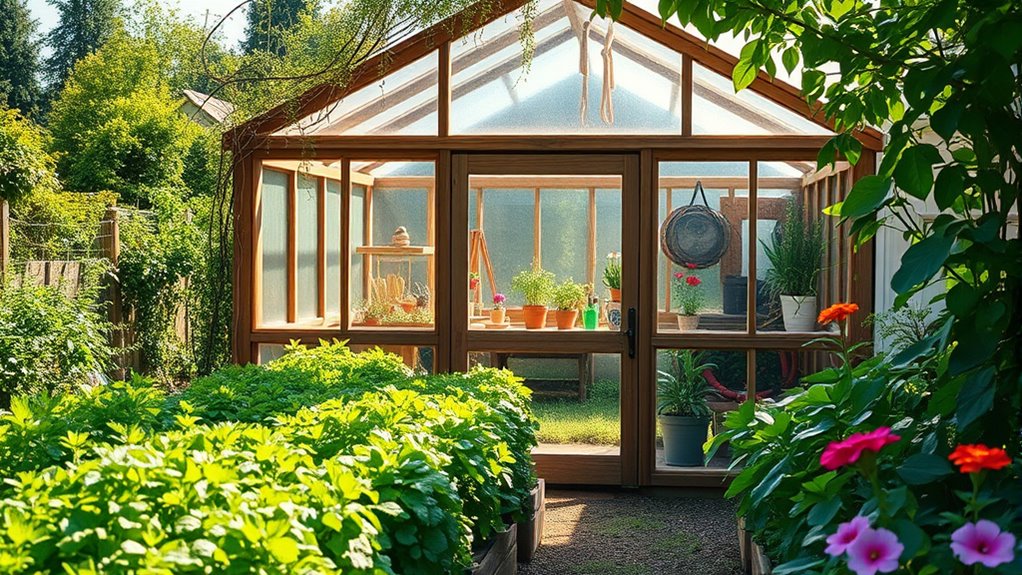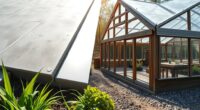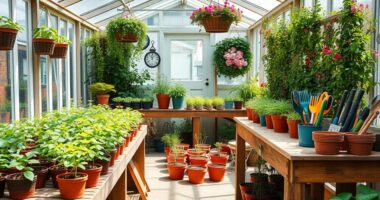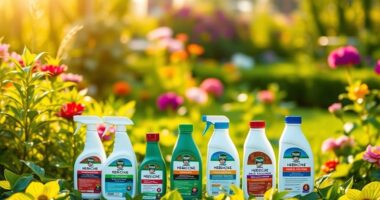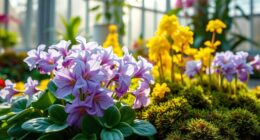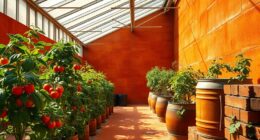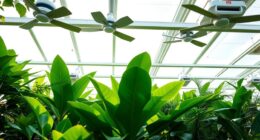If you're looking to grow your garden year-round, I've found some fantastic DIY greenhouse plans. From the practical step-by-step guidance in "Greenhouse Gardening for Beginners" to the detailed designs in the "Black & Decker Complete Guide to DIY Greenhouses," there's something for every skill level. Additionally, the 8×14 FT Green House and lightweight PVC options offer great flexibility. Let's explore these options further, so you can find the perfect greenhouse for your gardening needs.
Key Takeaways
- Explore "DIY Greenhouse Plans" for beginner-friendly, organic gardening methods and a year-round planting calendar to optimize yields.
- Consider "Black & Decker Complete Guide to DIY Greenhouses" for detailed plans and maintenance insights, despite some reported measurement inaccuracies.
- Utilize lightweight, affordable greenhouse structures for budget-friendly options, typically costing between $100-$150 with simple construction features.
- Look into the Greenhouse DIY Bracket Kit for expandable assembly options, allowing customization to fit various sizes and needs.
- Assess local climate and space requirements to ensure optimal greenhouse design, ensuring effective light capture and ventilation year-round.
Greenhouse Gardening for Beginners: Build Your Own Greenhouse

If you're just starting out in gardening and want to create your own greenhouse, "DIY Greenhouse Plans" is the perfect resource for you. It simplifies the process of building a greenhouse, offering clear, step-by-step instructions tailored for beginners. I found the year-round planting calendar especially helpful for planning my garden and maximizing yields. Plus, the book emphasizes organic methods, ensuring a healthy environment for my plants. You'll also discover practical tips for maintaining your greenhouse and managing common issues like pests. This guide has truly made greenhouse gardening accessible and enjoyable, making it an invaluable tool for any budding gardener.
Best For: Beginners looking to start their greenhouse gardening journey with practical guidance and easy-to-follow instructions.
Pros:
- Offers clear, step-by-step instructions for building and maintaining a greenhouse.
- Includes a year-round planting calendar to help maximize yields.
- Emphasizes organic gardening methods for a healthy plant environment.
Cons:
- Some readers may find the focus on greenhouse construction limits extensive gardening content.
- Might not provide advanced techniques for experienced gardeners.
- Limited coverage of specific plant varieties or advanced pest management strategies.
Black & Decker Complete Guide to DIY Greenhouses
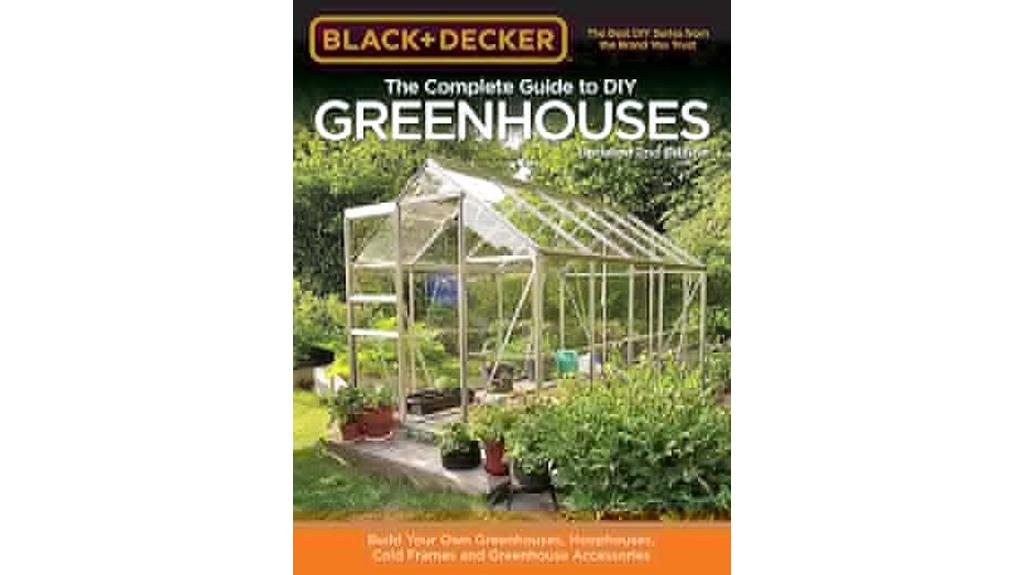
The "Black & Decker Complete Guide to DIY Greenhouses" is perfect for anyone enthusiastic to plunge into greenhouse construction, whether you're a novice gardener or a seasoned DIY enthusiast. This updated edition offers detailed plans for various structures, from hoophouses to cold frames. I found the extensive color photography and clear construction techniques invaluable. The book's organized layout makes it user-friendly, and its insights on ventilation and maintenance are practical. While I noted a few measurement inaccuracies, the guidance on building seed shelves taught me essential carpentry skills. Overall, it's an excellent resource that's helped me enhance my gardening experience.
Best For: The "Black & Decker Complete Guide to DIY Greenhouses" is best for both beginner gardeners and experienced DIY enthusiasts looking to build their own greenhouse structures.
Pros:
- Detailed construction plans and guidance for various greenhouse styles, including hoophouses and cold frames.
- Extensive color photography enhances understanding and provides visual support for projects.
- User-friendly layout with practical insights on ventilation, maintenance, and additional garden structures.
Cons:
- Some users reported inaccuracies in specific measurements, requiring adjustments during construction.
- May not provide in-depth information for advanced greenhouse techniques or specialized designs.
- Certain readers opted to purchase pre-built greenhouses instead of following the DIY guidance.
The Year-Round Solar Greenhouse Guide
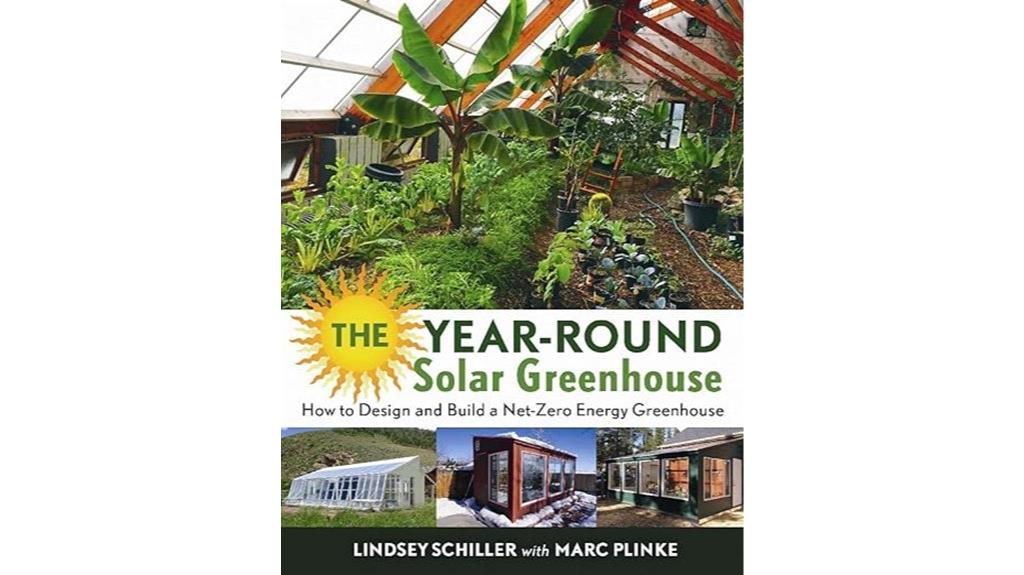
For those who crave fresh produce year-round, "The Year-Round Solar Greenhouse Guide" is an essential resource. I found its engaging writing style makes learning about greenhouse construction enjoyable. The guide covers various techniques to extend your growing season, though it's best suited for handy individuals who can adapt the information. One standout feature is the GAHT system, an innovative way to maintain heat during winter. With practical recommendations and suggestions for further reading, this book empowers both novices and seasoned builders. Overall, it's a valuable tool that boosted my confidence in creating an efficient solar greenhouse.
Best For: Those who are handy and interested in building solar greenhouses for year-round produce.
Pros:
- Engaging and clear writing style makes the content enjoyable and easy to understand.
- Comprehensive coverage of greenhouse building techniques and innovative systems like GAHT.
- Provides practical recommendations and further reading suggestions to enhance learning.
Cons:
- May lack detailed guidance on specific construction techniques for beginners.
- Best suited for individuals who can adapt information, which might be challenging for novices.
- Some readers may find it less useful without additional detailed resources for implementation.
Black and Decker Complete Guide to DIY Greenhouses (3rd Edition)
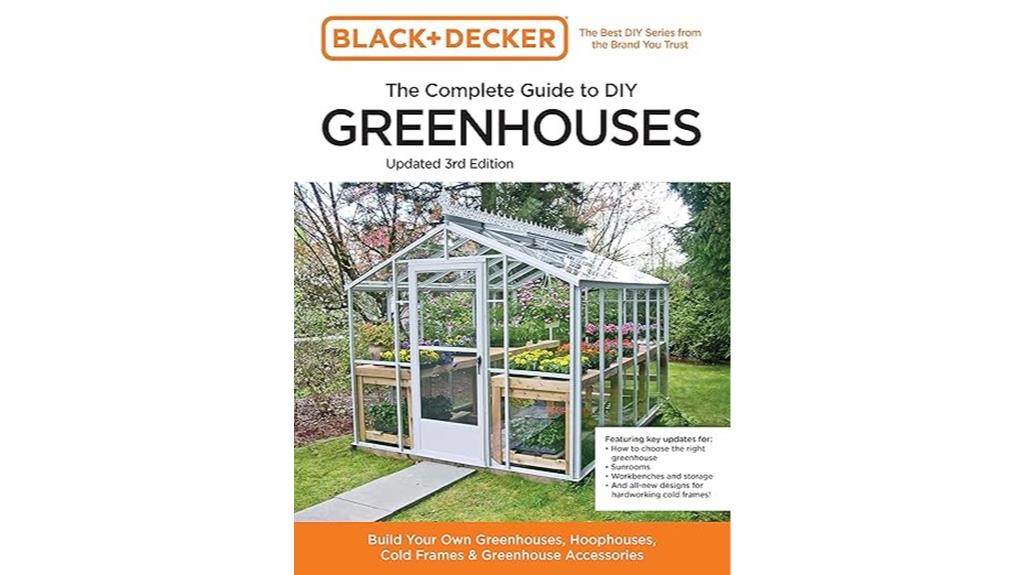
Packed with practical insights and stunning visuals, the "Black and Decker Complete Guide to DIY Greenhouses (3rd Edition)" is perfect for DIY enthusiasts and homeowners keen to create their own greenhouse. Released in June 2023, this updated edition features 240 pages of step-by-step tutorials, safety tips, and thematic chapters. I appreciate how it clearly outlines material choices and site planning, making it easy to follow. The detailed bullet lists of tools and materials really streamline the building process. Whether you're a novice or experienced builder, this guide is an invaluable resource for constructing a greenhouse tailored to your needs.
Best For: DIY enthusiasts, homeowners, and educational institutions looking to construct their own greenhouse.
Pros:
- Comprehensive step-by-step tutorials with clear photographs for easy following.
- Detailed bullet lists of materials and tools streamline the building process.
- Thematic chapters provide organized information on various greenhouse aspects, including planning and construction.
Cons:
- May be overwhelming for complete beginners due to the extensive information provided.
- Focuses primarily on North American standards, which may not suit international readers.
- Some advanced construction techniques may require additional resources or expertise not covered in the guide.
How to Build Your Own Greenhouse: Designs and Plans
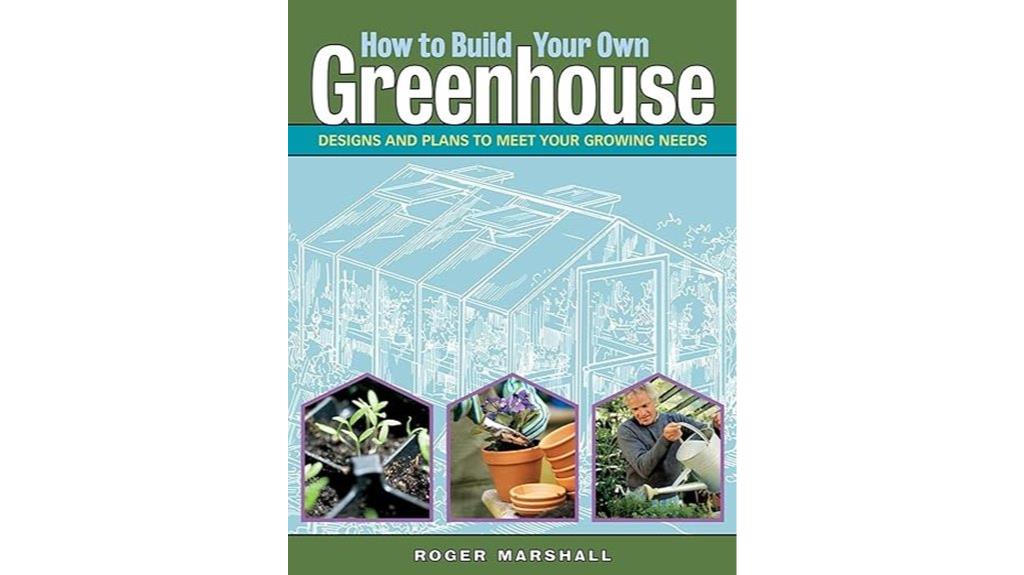
If you're a DIY enthusiast ready to take on a greenhouse project, "DIY Greenhouse Plans" is an excellent choice. This extensive guide covers various designs and materials tailored to your climate and plants. I appreciate how it simplifies complex concepts with clear visuals, making it accessible even for beginners. It's a solid reference for those considering future upgrades, though it doesn't dive deep into specialized topics like aquaponics. Compared to cheaper options, this book offers more valuable insights and is perfect for anyone aiming for professional-quality results. I highly recommend it for effective planning and construction of your greenhouse.
Best For: DIY enthusiasts looking for a comprehensive guide to building a professional-quality greenhouse.
Pros:
- Extensive design options: Covers various materials and structures suited to different climates and plant types.
- Beginner-friendly: Simplifies complex concepts with clear visuals, making it accessible for those without prior knowledge.
- Valuable resource: Provides practical advice for effective planning and construction, ideal for future upgrades.
Cons:
- Limited specialized topics: Offers minimal information on niche subjects like aquaponics, requiring readers to seek additional resources.
- Potentially overwhelming: May be too detailed for those only seeking basic greenhouse designs.
- Higher cost compared to alternatives: More informative than cheaper options, but may not be budget-friendly for every DIY builder.
VEIKOU 8×16 FT Greenhouse for Outdoors
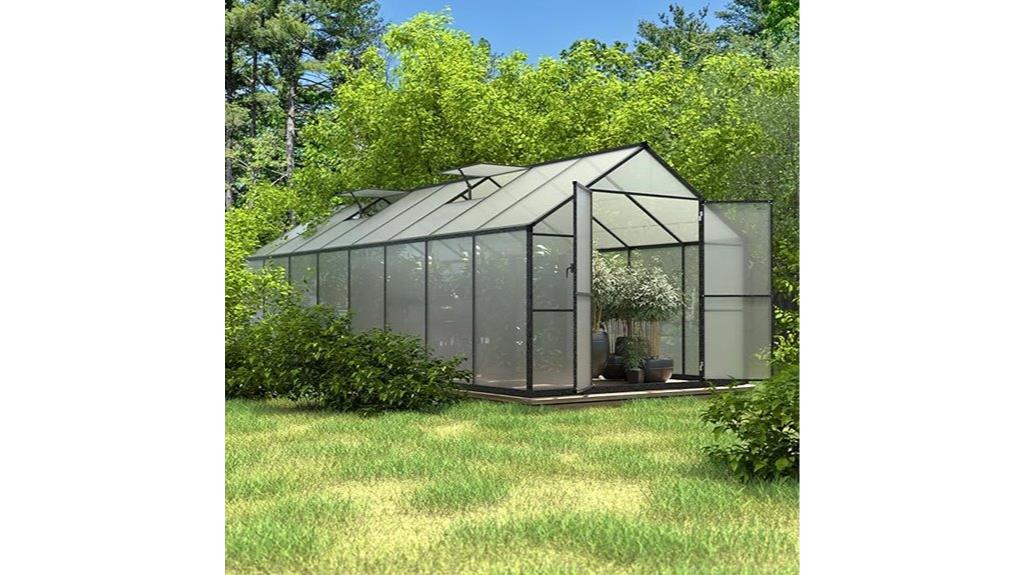
The VEIKOU 8×16 FT Greenhouse stands out as an ideal choice for avid gardeners seeking a robust and spacious structure to nurture their plants. With its durable gray powder-coated aluminum frame and 4mm double-layer polycarbonate panels, it offers excellent thermal insulation and weather resistance. The adjustable roof vents guarantee proper ventilation, while the user-friendly design simplifies assembly. Although some components may need adjustments, I found the greenhouse sturdy and effective for plant growth. However, be prepared for potential upgrades, like sealing panels and replacing lower-quality hinges. Overall, it's a solid investment for any serious gardener.
Best For: Avid gardeners looking for a durable and spacious greenhouse to enhance plant growth.
Pros:
- Sturdy gray powder-coated aluminum frame provides excellent weather resistance.
- 4mm double-layer polycarbonate panels offer superior thermal insulation compared to glass.
- Adjustable roof vents promote proper ventilation for optimal plant health.
Cons:
- Some assembly components may arrive bent, requiring adjustments during setup.
- Vent hinges and levers may be of lower quality and may need replacement.
- Initial costs can escalate with necessary upgrades like sealing panels.
Greenhouse Gardening for Beginners: Build Your Own Greenhouse
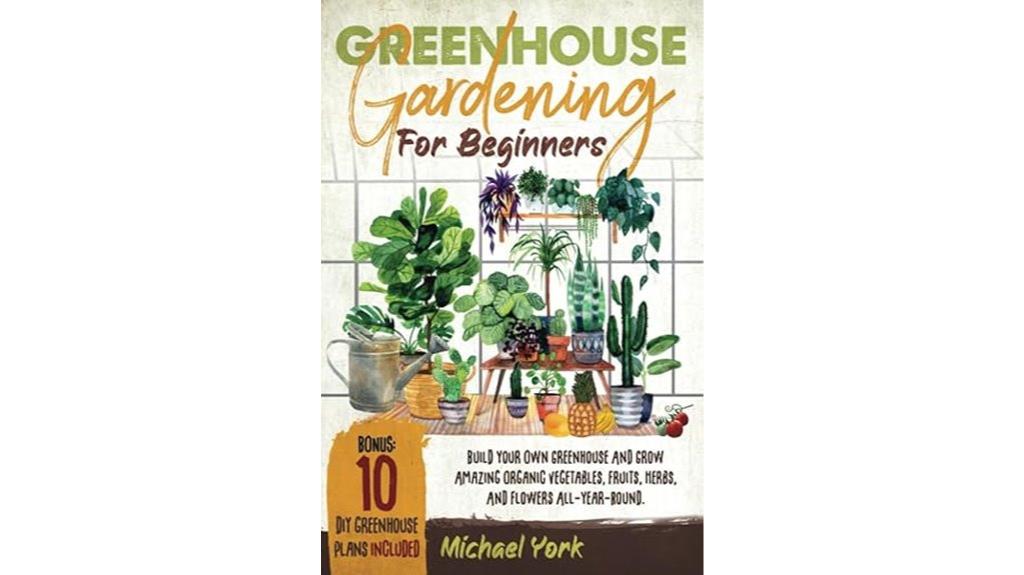
Building your own greenhouse is an exciting project for anyone enthusiastic to immerse themselves in greenhouse gardening, especially beginners. Michael York's book, "Greenhouse Gardening for Beginners," provides step-by-step guidance to help you create and maintain your greenhouse. It covers everything from choosing the right materials to managing temperature and humidity. You'll find a year-round planting calendar, which is essential for maximizing your yields. Plus, there are practical tips on pest control and troubleshooting common issues. This resource is perfect if you're looking to grow a variety of plants while keeping your gardening budget-friendly. Let's get started on your greenhouse journey!
Best For: Beginners and novice gardeners looking to start their greenhouse gardening journey with practical guidance and budget-friendly tips.
Pros:
- Step-by-step instructions make it easy for beginners to build and maintain their greenhouse.
- Includes a year-round planting calendar to maximize yields and ensure continuous production.
- Offers practical advice on pest control and troubleshooting common issues, enhancing gardening success.
Cons:
- Some readers may find the focus on greenhouse construction limits in-depth gardening content.
- Experienced gardeners might not find advanced techniques or insights in the book.
- DIY projects may require additional resources or materials that could increase costs for some.
Greenhouses & Garden Sheds: Inspiration & Information
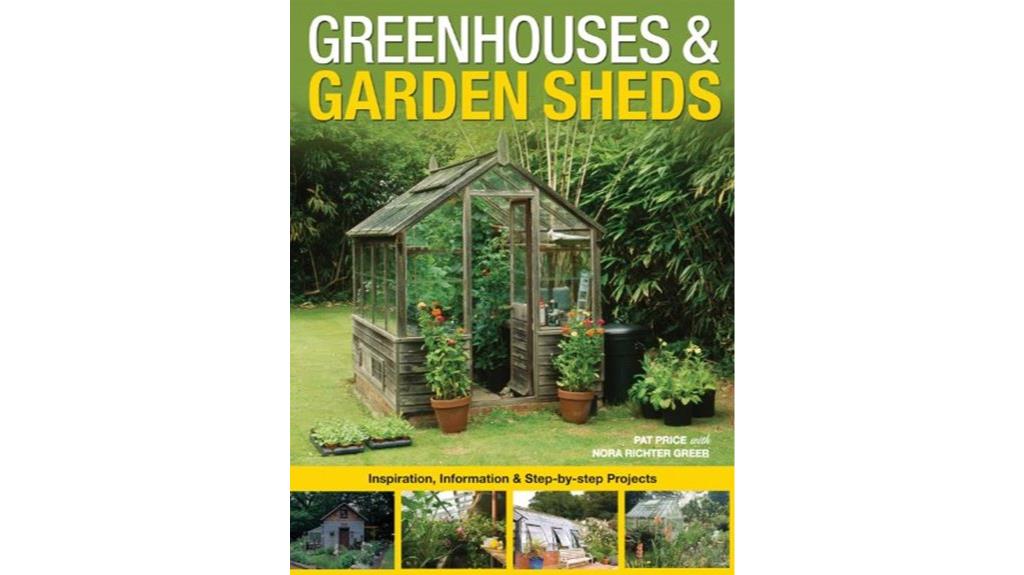
For anyone enthusiastic to plunge into the world of gardening, "DIY Greenhouse Plans" is an excellent choice, especially if you're new to constructing your own growing spaces. This guide, "Greenhouses & Garden Sheds," offers a wealth of inspiration and practical information. It covers essential topics like positioning, structure design, and internal layout, making it easy for me to visualize my projects. The clear language and helpful visuals enhance the learning experience, while the extensive content guarantees I can find the right plans for my needs. Many readers rave about its clarity, making it a must-have for aspiring gardeners like me.
Best For: Beginners looking for comprehensive guidance on building and using greenhouses and garden sheds.
Pros:
- Extensive information covering various greenhouse types and construction plans.
- Clear vocabulary and helpful visuals that enhance understanding.
- Highly recommended by readers for its practical tips and easy-to-follow instructions.
Cons:
- Some readers feel it lacks detailed guidance in pictures and construction specifics.
- May not provide advanced techniques for experienced gardeners.
- Limited information on specific plant care within the greenhouse context.
How to Build a Greenhouse

If you're a beginner looking to plunge into gardening, DIY Greenhouse Plans can be a great choice for you. However, I found that some resources, like a certain beginner's book on greenhouse building, lack practical details. It didn't provide a lumber list or any helpful sketches. While it offered multiple build examples, the instructions were pretty generic. I was disappointed to see the last pages filled with ads for other books. Personally, I discovered better information for free online. So, I recommend exploring various sources to find the best greenhouse plans that truly meet your needs.
Best For: Beginners looking to start gardening with basic greenhouse plans.
Pros:
- Filled with multiple build examples suitable for beginners.
- Offers a lot of information to get started on greenhouse building.
- Encourages exploration of different greenhouse designs.
Cons:
- Lacks practical resources like a lumber list and visual aids.
- Contains generic instructions that may not be very helpful.
- Last pages are filled with advertisements for other books, which can be distracting.
40 Projects for Building Your Backyard Homestead
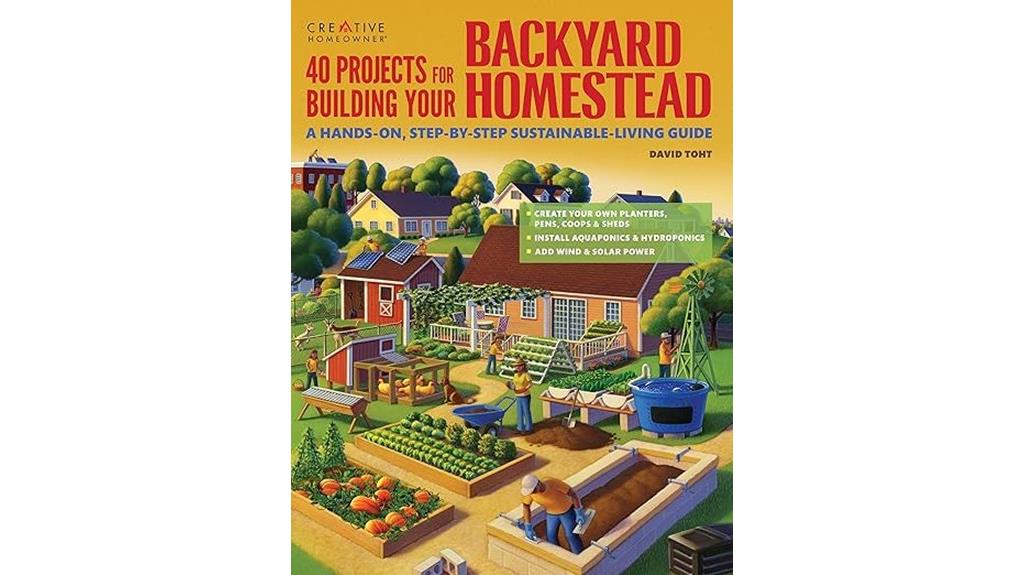
A DIY greenhouse is the perfect project for anyone looking to extend their growing season and cultivate a wider variety of plants right in their backyard. If you're keen to embrace homesteading, consider exploring the "40 Projects for Building Your Backyard Homestead" book. It's packed with step-by-step instructions for projects like chicken coops, fences, and raised gardens. I found the detailed diagrams and material lists incredibly helpful, especially as a beginner. While some projects may seem simple for experienced builders, they're ideal for novices wanting to gain confidence in building and self-sufficiency. Let's get started on your backyard journey!
Best For: This book is best for beginners in homesteading and woodworking who are looking to develop their skills through practical DIY projects.
Pros:
- Detailed step-by-step instructions and comprehensive material lists help beginners succeed in their projects.
- Excellent diagrams and illustrations make the content user-friendly and accessible.
- Offers a variety of practical projects that encourage self-sufficiency in backyard homesteading.
Cons:
- Experienced builders may find the projects too basic and lacking in complexity.
- Some physical copies may arrive with defects, such as torn covers or misprinted pages.
- Limited advanced techniques or projects may not fully satisfy seasoned homesteaders.
8×14 FT Green House for Outdoor
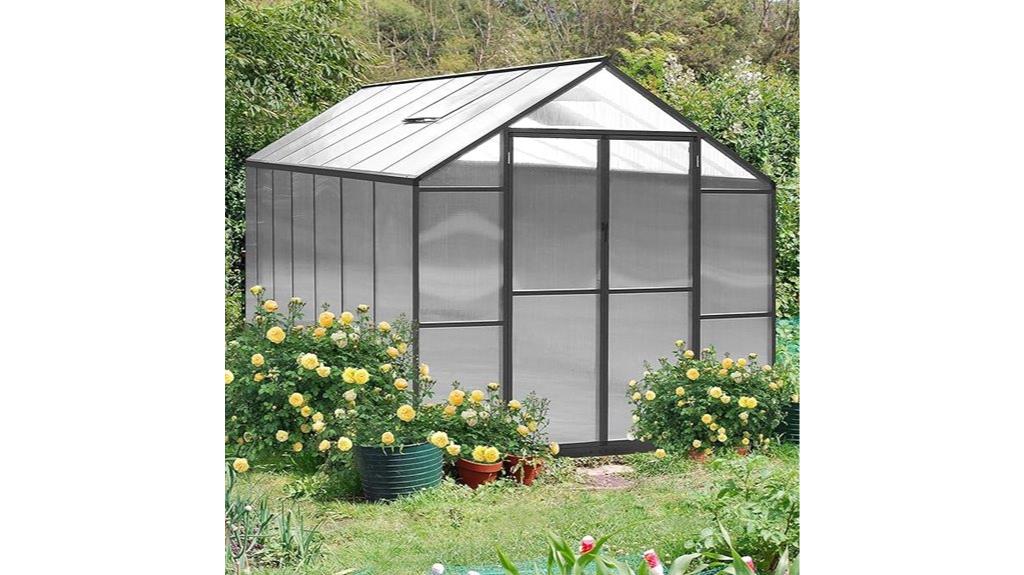
The 8×14 FT Green House for Outdoor is perfect for gardeners who want a spacious and durable environment for their plants. With its high-quality aluminum frame and thick polycarbonate panels, it's designed to withstand various climates. I love the two adjustable roof vents that guarantee proper ventilation, and the lockable door provides easy access and security. This greenhouse isn't just for plants; it offers plenty of room for garden tools and even a spot for kids to play. Assembly is quick, making it a fantastic choice for anyone looking to enhance their gardening experience year-round.
Best For: Gardeners seeking a spacious and durable greenhouse that offers versatility for planting, storage, and recreational use.
Pros:
- High-quality aluminum frame ensures durability and resistance to corrosion and weather.
- Thick polycarbonate panels provide excellent warmth and sunlight absorption for optimal plant growth.
- Two adjustable roof vents and a lockable door enhance ventilation and security.
Cons:
- Assembly may still require some time and effort despite being upgraded for a shorter process.
- Shipping in two boxes may lead to potential delays in receiving the complete product.
- Limited customer ratings could indicate less feedback on long-term performance.
PVC Greenhouse Plans DIY Hoop House
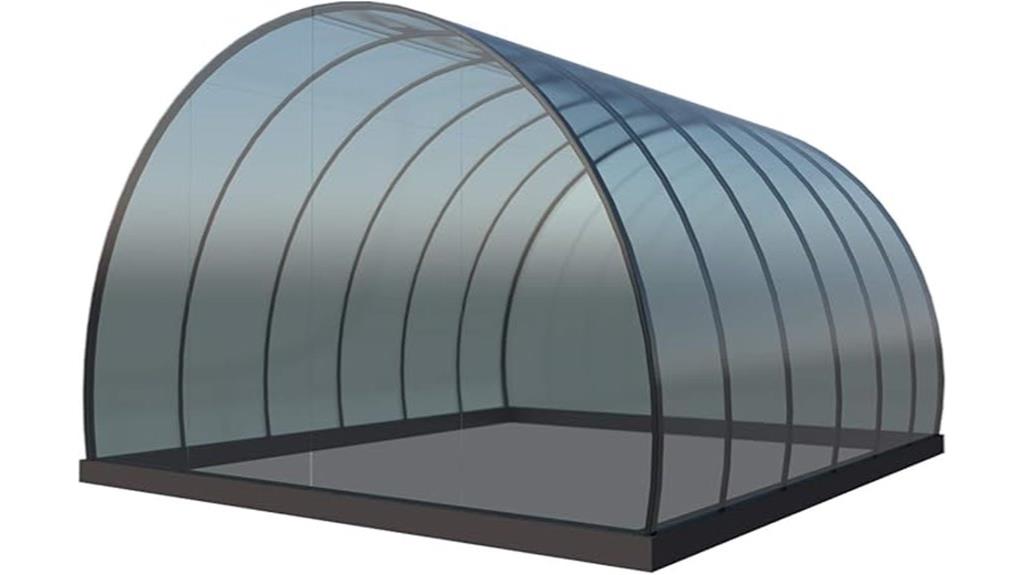
For gardeners looking to extend their growing season without breaking the bank, the PVC Greenhouse Plans DIY Hoop House offers an ideal solution. Measuring 10×12 feet, this lightweight structure is perfect for growing vegetables and plants. At just $100-$150, it's a fraction of the cost of traditional greenhouses, which can exceed $1200. The simple PVC and wood construction guarantees sturdy climate control while allowing easy off-season removal. Designed by Ben Stone, an experienced engineer, this plan includes modern AutoCAD drawings and tips for enhancing rigidity. With a 5-star rating, it's a top choice for any gardening enthusiast.
Best For: Gardeners seeking an affordable and effective way to extend their growing season.
Pros:
- Lightweight design allows for easy seasonal setup and removal.
- Cost-effective compared to traditional greenhouses, saving you money.
- Includes helpful tips and modern drawings for enhanced construction accuracy.
Cons:
- May require additional materials for improved rigidity.
- Limited size may not accommodate larger gardening projects.
- As a DIY plan, some users may need prior construction experience.
Greenhouse DIY Bracket Kit (Made in The USA)
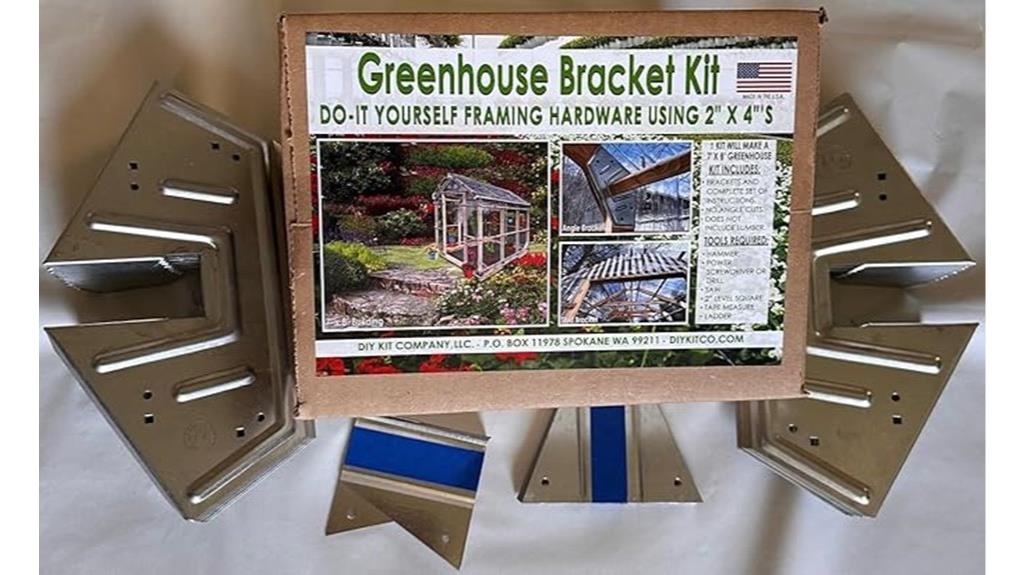
Looking to build your own greenhouse without the hassle of complicated cuts? The Greenhouse DIY Bracket Kit is perfect for you! It includes 24 angle brackets, 11 base plates, four corner base plates, and a thorough set of plans. With an expandable design, one kit fits a 7×8 structure, while two kits accommodate an 8×14, and three kits are ideal for a 10×22. Made from durable alloy steel and aluminum, this lightweight kit simplifies assembly—no angled cuts required! Plus, it's proudly made in the USA. I found the instructions clear, making it accessible for anyone to build.
Best For: Those looking to build a greenhouse easily without requiring advanced carpentry skills.
Pros:
- Simple assembly with no angled cuts needed, making it user-friendly for beginners.
- Expandable design allows for various sizes of greenhouses with additional kits.
- Made in the USA with durable materials, ensuring quality and longevity.
Cons:
- Lumber is not included, requiring additional purchases of 2x4s.
- Some customers have suggested that the instructions could be clearer.
- The product's customer rating indicates room for improvement in overall satisfaction.
Factors to Consider When Choosing DIY Greenhouse Plans
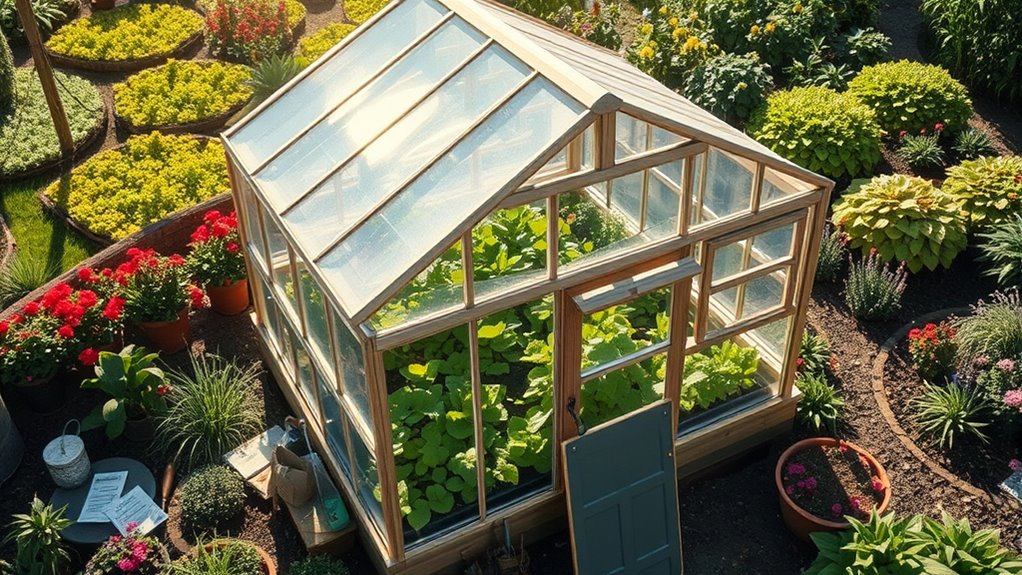
When I think about choosing DIY greenhouse plans, I consider a few key factors. It's important to look at my budget, the space I have available, and how the climate in my area will affect my greenhouse. I also want to make sure the materials are durable and that I can assemble everything without too much hassle.
Budget and Cost Factors
Choosing the right DIY greenhouse plans involves careful consideration of budget and costs, especially since materials can vary widely in price. I've seen simple PVC structures cost around $100, while more elaborate designs can exceed $1,200. Don't forget to factor in additional expenses like tools, fasteners, and accessories, which can really add up. If you're buying plans or kits online, shipping costs can also vary, so keep that in mind. To stretch your budget, consider upcycling materials; it's a great way to save money while still achieving a functional design. Ultimately, think about the long-term savings from homegrown produce, which can help offset your initial investment over time. It's a worthwhile consideration!
Size and Space Requirements
After considering your budget and costs, the next step is to think about size and space requirements for your DIY greenhouse. You'll want to guarantee it fits comfortably within your outdoor area, providing enough room for access and sunlight. The height matters too—if you're planning to grow tall plants or use vertical gardening, make sure there's ample headspace. Assess the footprint based on your gardening goals; smaller structures are great for herbs, while larger ones support diverse plants. Don't forget about zoning regulations and property lines, as they can limit the size and placement of your greenhouse. By carefully considering these factors, you'll create a functional and enjoyable growing space.
Climate and Environment Considerations
Understanding your local climate and environment is essential for creating an effective DIY greenhouse. I always consider temperature extremes, humidity levels, and precipitation patterns, as these will influence the structure and materials I choose. It's important to pick a design that captures sunlight in winter while providing shade in summer to keep my plants thriving. I also assess wind patterns and potential weather events, which help me determine how robust my greenhouse needs to be and how to anchor it securely. Additionally, I evaluate available water sources and drainage solutions, as proper irrigation is crucial. Finally, I research local pests and diseases to inform my decisions on ventilation and pest control measures, ensuring a healthy growing environment for my plants.
Material Durability and Quality
When I select materials for my DIY greenhouse, I prioritize durability and quality to guarantee it stands the test of time and weather. I often opt for high-quality aluminum or polycarbonate, as these materials enhance longevity and resist various climatic conditions. Polycarbonate panels, around 4mm thick, provide excellent thermal insulation and impact strength, making them a top choice for stable internal temperatures. I also look for rust-resistant, powder-coated aluminum frames to prevent degradation, especially in humid areas. Proper sealing with silicone on panel edges is essential to prevent wind damage and maintain structural integrity. Finally, using recyclable materials not only promotes sustainability but can also cut costs while ensuring a sturdy greenhouse structure.
Assembly Complexity and Tools
Choosing the right materials is just the first step; the complexity of assembly is another significant factor in selecting DIY greenhouse plans. I've found that some plans demand advanced carpentry skills, while others cater to beginners with straightforward, step-by-step instructions. It's important to check if the plans specify the tools needed, as having the right equipment can make a world of difference. I always look for designs that include clear diagrams and written instructions, which really help clarify the assembly steps. Additionally, evaluating the required materials is essential—some designs need specific lumber or hardware. Finally, consider whether the plans offer unique features like adjustable components, as these can simplify assembly and allow for future modifications.
Purpose and Plant Types
Determining the purpose of your greenhouse and the types of plants you want to grow is essential for making the right DIY greenhouse choice. I recommend evaluating whether you plan to cultivate seasonal vegetables, year-round crops, or delicate plants, as this impacts your design and materials. Different plants have unique temperature, humidity, and light requirements, so consider those factors carefully. Also, think about your local climate; if you live in a colder area, you'll need insulation, while warmer regions may require enhanced ventilation. Finally, make sure your greenhouse size accommodates the number of plants you wish to grow and allows for adequate space for maintenance. Features like adjustable vents or heating systems can further optimize growth conditions for your chosen plants.
Maintenance and Upkeep Needs
After you've settled on the purpose of your greenhouse and the types of plants you'll be growing, it's time to think about maintenance and upkeep needs. Regularly cleaning both the interior and exterior surfaces is vital; it maximizes sunlight exposure and prevents diseases. I always check for leaks or damages in the structure to maintain ideal temperature and humidity levels. Routine inspections for pests and diseases help keep plants healthy, and I apply pest control measures as needed. Don't forget to test and adjust your heating and cooling systems according to seasonal changes. Finally, maintaining proper irrigation systems is essential—be sure to check for clogs and guarantee adequate drainage to prevent water-related issues that could harm your plants.
Aesthetic and Design Preferences
When it comes to designing your DIY greenhouse, you'll want to make sure it fits seamlessly with the overall aesthetic of your home and garden. Consider the architectural style of your space; a traditional, modern, or rustic design can greatly enhance visual appeal. The materials you choose are equally important, impacting both appearance and durability. I recommend exploring various options that align with your style while ensuring easy maintenance. Don't forget about the internal layout—shelving and plant arrangements can maximize space while keeping things attractive. Ultimately, incorporating elements like windows, vents, and decorative features not only boosts functionality but also enriches the overall look of your outdoor area. Choose wisely for a greenhouse that complements your garden's charm!
Frequently Asked Questions
What Materials Are Best for Building a DIY Greenhouse?
When I'm building a DIY greenhouse, I usually opt for sturdy materials that can withstand the elements. I love using PVC pipes for the frame because they're lightweight yet durable. For the covering, clear polycarbonate panels are my go-to; they offer great insulation and let in plenty of light. If I'm on a budget, repurposed windows work well too! Choosing the right materials really makes a difference in the greenhouse's effectiveness.
How Much Sunlight Do Greenhouses Need for Optimal Growth?
They say, "You can't have too much of a good thing," but when it comes to sunlight in greenhouses, that's not quite true! I've found that most plants thrive with about six to eight hours of direct sunlight daily. Too much can lead to overheating, so I always guarantee proper ventilation. If you're growing shade-loving plants, filtered light works wonders. Keeping an eye on light levels really helps my garden flourish!
Can I Use Recycled Materials for My Greenhouse Construction?
Absolutely, I've used recycled materials for my greenhouse, and it worked out great! I found old windows and doors that provided excellent light and insulation. Not only did I save money, but I also felt good about reducing waste. Just make sure the materials are sturdy and clean. It's a fun project that adds character to my garden, and I love knowing I'm being eco-friendly while growing my plants.
What Are the Best Plants to Grow in a Greenhouse Year-Round?
When I think about the best plants to grow in a greenhouse year-round, I often choose a mix of vegetables and herbs. For me, tomatoes, peppers, and cucumbers thrive in those controlled conditions. I love growing leafy greens like lettuce and spinach, too—they're quick to harvest! Herbs like basil and cilantro add great flavor to my dishes. With the right care, my greenhouse becomes a year-round source of fresh produce.
How Do I Maintain the Temperature Inside My Greenhouse?
Maintaining the temperature inside my greenhouse has been a game-changer for my plants. I regularly check the thermometer and adjust ventilation as needed. On sunny days, I open the windows to let in fresh air. I also use shade cloths to block excessive heat. At night, I close everything up to retain warmth. A heater helps when it gets chilly, ensuring my greenhouse stays cozy for year-round growth. It's all about balance!
Conclusion
Building your own greenhouse can be a rewarding journey, transforming simple materials into a thriving garden sanctuary. Whether you're drawn to the sturdy designs of the Black & Decker guide or the innovative charm of a PVC hoop house, there's a plan that fits your style. Embrace the joy of nurturing plants year-round, while also experiencing the challenges of construction. In this blend of creation and cultivation, you'll find not just a greenhouse, but a newfound passion for gardening.
